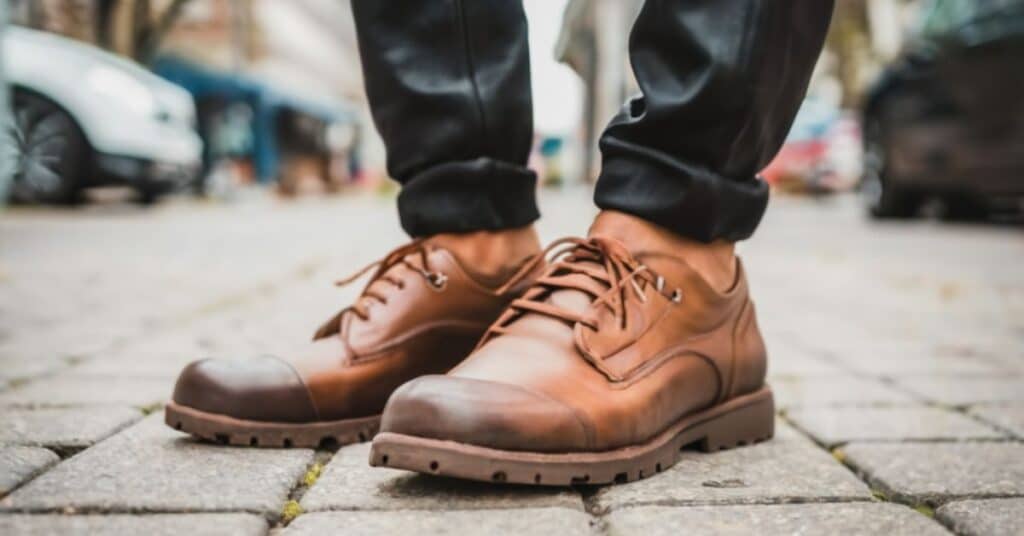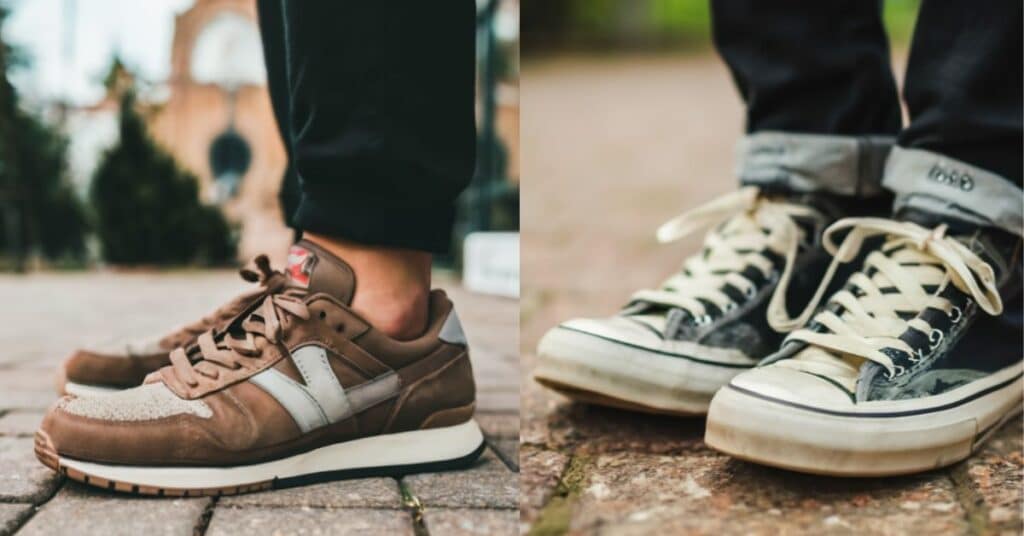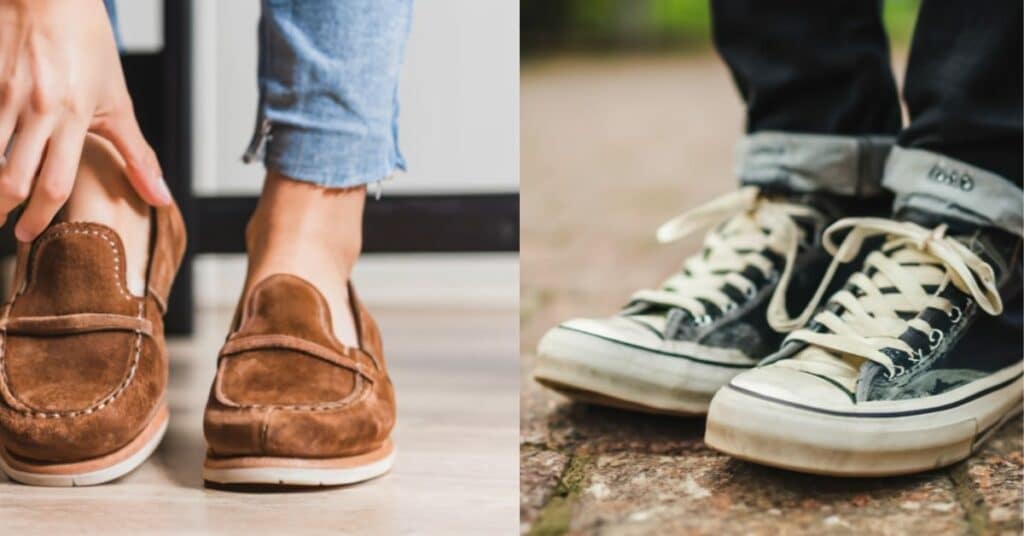Simple yet effective ways to banish mold from your shoes with ease. Mold growth on shoes is not only unsightly but also can lead to unpleasant odors and damage.
Don’t let mold ruin your favorite footwear! Learn how to combat this problem head-on with natural remedies and targeted cleaning techniques. From vinegar solutions to baking soda scrubs, you’ll find practical tips to restore your shoes to their former glory. Say goodbye to moldy shoes and hello to fresh, mold-free footwear!
How to remove mold from shoes?
When tackling mold on shoes, start by brushing off loose spores outdoors to prevent spreading. Then, mix equal parts water and vinegar, and gently wipe affected areas with a cloth. Let shoes dry in sunlight, which helps kill mold spores effectively.
Create a paste with baking soda and water, apply it to moldy spots, and scrub gently. Rinse off with water and ensure shoes are completely dry before wearing to prevent future mold growth. These simple yet effective methods will leave your shoes mold-free and fresh.
Natural Remedies for Mold Removal on Shoes
When dealing with mold on shoes, natural remedies offer effective solutions. Start by brushing off loose spores outdoors to prevent spreading. Then, mix equal parts water and vinegar, gently wipe affected areas, and let shoes dry in sunlight to kill mold spores. Create a paste with baking soda and water, apply it to moldy spots, scrub gently, and rinse off with water. Ensure shoes are completely dry before wearing to prevent future mold growth. These simple methods will leave your shoes mold-free and fresh, ready for wear without the worry of lingering mold.
Effective Techniques to Eliminate Mold from Footwear
Natural remedies like vinegar or baking soda effectively eliminate mold from shoes. Brush off loose spores, then use a water-vinegar solution or baking soda paste to clean affected areas. Let shoes dry in sunlight to prevent future mold growth.
Where does mold on shoes come from?

Mold on shoes typically originates from damp conditions and poor ventilation. Moisture trapped inside shoes creates an ideal environment for mold growth. Wearing shoes in humid or rainy weather increases the likelihood of mold development.
Storing shoes in dark damp areas such as closets or basements contributes to mold formation. Mold spores present in the air settle on the shoes, finding nourishment in the moisture and organic materials present in the footwear. Regularly airing out and properly drying shoes after wear can help prevent mold buildup.
Causes of Mold Growth on Shoes
Mold growth on shoes is often caused by moisture and poor ventilation. When shoes remain damp after wear or exposure to wet conditions, mold spores find an ideal environment to thrive. Storing shoes in dark, humid areas like closets or basements encourages mold formation. Properly drying shoes after wear and ensuring adequate ventilation can help prevent mold growth and keep footwear fresh and mold-free.
Factors Contributing to Shoe Mold Formation
Factors contributing to shoe mold formation include moisture accumulation and inadequate ventilation. When shoes are not properly dried after wear or exposed to humid environments, mold spores find optimal conditions for growth. Additionally, storing shoes in dark, damp areas like closets or basements provides a breeding ground for mold. By addressing these factors through proper drying and storage practices, you can prevent mold formation and maintain your shoes in good condition.
Get rid of mold on my shoes?

To rid your shoes of mold, start by brushing off any loose spores outdoors. Then, create a mixture of equal parts water and vinegar, wiping the affected areas with a cloth. Let your shoes dry in sunlight to kill mold spores effectively. Alternatively, you can make a paste with baking soda and water, apply it to the moldy spots, scrub gently, and rinse with water. Ensure your shoes are completely dry before wearing them again to prevent future mold growth.
Furthermore, maintaining proper ventilation and storing shoes in a dry environment can prevent mold from reoccurring. Consider investing in shoe deodorizers or silica gel packets to absorb excess moisture. Regularly inspect your shoes for signs of mold and promptly address any issues to keep them mold-free. By following these steps, you can ensure your shoes remain fresh and free from mold contamination.
Effective Methods for Removing Mold from Shoes
To effectively remove mold from shoes, start by brushing off loose spores outdoors to prevent further spread. Then, use a mixture of water and vinegar or a baking soda paste to scrub the affected areas gently. Let your shoes dry completely in sunlight to kill remaining mold spores and prevent future growth. These methods will help restore your shoes to a mold-free condition, ready for wear once again.
Preventive Measures to Keep Shoes Mold-Free
To keep your shoes mold-free, ensure they are thoroughly dried after wear to prevent moisture buildup. Store shoes in well ventilated areas with sufficient airflow to discourage mold growth. Consider using shoe deodorizers or silica gel packets to absorb excess moisture and keep shoes fresh. By implementing these preventive measures, you can maintain mold-free footwear and prolong the lifespan of your shoes.
How to avoid mold on shoes?
To avoid mold on shoes, start by ensuring they are completely dry before storing them. Remove any moisture by placing them in a well-ventilated area or using a shoe dryer. Additionally, regularly clean and air out your shoes to prevent mold spores from settling.
Store shoes in a cool, dry place with good airflow to discourage mold growth. Consider using shoe deodorizers or silica gel packets to absorb excess moisture. By taking these preventative measures, you can effectively avoid mold on your shoes and keep them fresh and mold-free for longer periods.
How to store shoes so that they do not rot?

Proper shoe storage is essential to prevent them from rotting. Ensure shoes are completely dry before storing them to avoid moisture buildup, which can lead to rot. Store shoes in a cool, dry place away from direct sunlight and humidity to maintain their integrity.
Avoid storing shoes in plastic bags or airtight containers, as this can trap moisture and promote mold growth. Instead, opt for breathable storage solutions like shoe racks or open shelves. Consider using shoe trees or stuffing shoes with newspaper to help maintain their shape and absorb excess moisture. By following these tips, you can store your shoes effectively and prevent them from rotting.
Equipment / Tools
Equipment and tools are essential for various tasks and activities. From basic hand tools like hammers and screwdrivers to specialized equipment like power drills and saws, having the right tools can make any job easier. Additionally, equipment such as computers and software are crucial for modern-day tasks like data analysis and graphic design, enhancing efficiency and productivity. Having access to a well-equipped toolbox or workstation ensures you’re prepared for any project or task that comes your way.
Materials
Materials are the building blocks of countless projects and creations. Whether it’s wood, metal, plastic, or fabric, the right materials are essential for bringing ideas to life. From construction materials like lumber and concrete to artistic materials like paint and clay, each serves a unique purpose in various industries and endeavors. Understanding the properties and characteristics of different materials enables craftsmen, artists, and builders to choose the most suitable ones for their specific needs, ensuring the success and quality of their work.
Kill the Spores
To effectively kill spores, start by identifying the source of contamination and addressing it promptly. Utilize appropriate cleaning agents such as bleach or hydrogen peroxide to disinfect surfaces where spores may be present. Ensure thorough ventilation during cleaning to prevent the spread of spores.
Wipe Down Surfaces
To eliminate contaminants, wipe down surfaces regularly using disinfectant wipes or cleaning solutions. Pay attention to high-touch areas like doorknobs, countertops, and light switches. This simple practice helps prevent the spread of germs and maintains a clean environment for health and safety.
Frequently Asked Question
How does mold develop on shoes?
Mold on shoes typically develops in moist environments where there’s limited airflow, such as damp closets or wet weather conditions.
Can I remove mold from my shoes at home?
Yes, you can remove mold from shoes at home using simple household ingredients like vinegar, baking soda, or a mixture of water and detergent.
Will sunlight help kill mold on shoes?
Yes, sunlight is effective in killing mold spores. After cleaning your shoes, let them dry outdoors in direct sunlight to help eliminate any remaining mold.
How can I prevent mold from returning to my shoes?
To prevent mold from returning, ensure your shoes are completely dry before storing them and store them in a well-ventilated area with good airflow.
Can I still wear shoes that had mold on them?
Once you have effectively removed the mold, your shoes should be safe to wear. Just ensure they are completely dry before wearing them again to prevent any potential health issues.
Final Thoughts
To get rid of mold on shoes, start by brushing off any loose spores outdoors to prevent further spread. Then, create a mixture of equal parts water and vinegar or a baking soda paste to scrub the affected areas gently. Your shoes dry completely in sunlight to kill remaining mold spores and prevent future growth. You can use a commercial mold remover specifically designed for shoes, following the manufacturer’s instructions carefully for best results.
Using preventative measures to keep your shoes mold-free in the future. Ensure your shoes are completely dry before storing them and store them in a cool, dry place with good airflow. Regularly inspect your shoes for signs of mold and promptly address any issues to prevent mold from returning. By following these steps, you can effectively remove mold from your shoes and keep them fresh and mold-free for longer periods.








